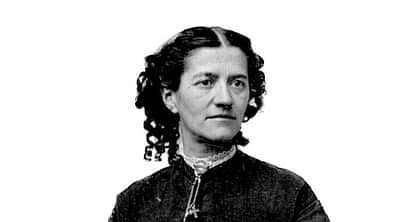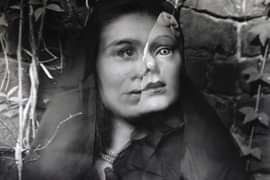April 01, 2021
Andover’s remarkable herstory
Eight women whose leadership to Abbot and Phillips academies has stood the test of timeby Allyson Irish
Facing Forward, Together
Teamwork. Partnership. Collaboration. For generations, the best organizations in the world have relied on these principles in their pursuit of excellence.
Phillips and Abbot academies have benefited from these principles and from two formidable women-led teams that have embraced them—14th Head of School Barbara Landis Chase and Associate Head of School Rebecca M. Sykes, and Abbot Academy Principal Philena McKeen and her sister, Assistant Principal Phebe McKeen.
 14th Head of School Barbara Landis Chase
14th Head of School Barbara Landis Chase
Chase’s appointment was historic. Even the New York Times paid attention when—in 1994—one of the country’s oldest preparatory schools founded for boys appointed its first woman head. While Chase’s appointment was widely celebrated, some were opposed to a woman leader. Undaunted, Chase moved Andover forward with a clear sense of purpose and her philosophy of being a “leader for all.” She developed a superb team that included Sykes, whose Andover resume includes work as a college counselor, residential dean and dean of Community and Multicultural Development, and ended with a 17-year run as associate head of school.
Chase’s 18-year tenure covered an array of initiatives, including the strengthening of financial aid, which led to the Academy’s need-blind admission policy; growth of outreach and global programs; and significant facilities improvements, from academics to athletics. Many of these initiatives were made possible by two campaigns that together raised $500 million. The focus during this period was on educating the “whole student,” which began with a restructuring of residential life and student services.
 Rebecca M. Sykes
Rebecca M. Sykes
Both women have left their mark, quite literally, on the campus. In 2016, the Academy opened the Rebecca M. Sykes Wellness Center, the first building named for an African American woman. The following year, Chase House was dedicated.
After leaving Andover in 2013, Sykes went on to work for the Oprah Winfrey Charitable Foundation. She and Chase are now working together again at Carney, Sandoe & Associates.
In a 2012 letter sent to Chase acknowledging her retirement, Faculty Emeritus Vic Henningsen ’69 wrote, “When you interviewed for the job, you said that you saw your charge as ‘supporting the main event.’ When Susan (McCaslin) and I interviewed you for the Andover Bulletin, you asserted ‘Good schools face forward.’ There, less than six months apart, were two statements of principle that you’ve followed throughout your long and successful tenure.”
 Philena McKeen
Philena McKeen
Another team with a long and successful tenure, the McKeen sisters—sometimes referred to as Abbot’s “Binary Star”—led Abbot Academy through a series of improvements 150 years earlier, “…ushering in a kind of golden age full three decades long during which Abbot prospered as never before…” wrote Faculty Emerita Susan Lloyd in A Singular School.
Hailing from Vermont, the McKeen sisters were two of seven children. Their father, a minister, taught the children himself, and both Philena and Phebe went on to teach at schools and boarding seminaries starting at the age of 16.
The sisters arrived at Abbot in 1859 and set to work expanding buildings, grounds, and teaching resources, as well as improving the curriculum, the school’s relationship with the town of Andover, and bringing in well-known speakers such as Helen Keller.
 Phebe McKeen
Phebe McKeen
Frugality and resourcefulness were hallmarks of the McKeens. Lloyd shares how the sisters required all wastepaper to be saved; they sold the paper and used the proceeds to buy framed pictures to decorate the classrooms. In another instance, Philena—frustrated by the meager set of silverware the school was using—invited the trustees to tea using the “ghastly set of cheap alloy dessert spoons…that had an annoying tendency to upset the teacups.” Soon after, one of the trustees sent over a set of several dozen monogrammed silver spoons.
With Dignity and Respect
Donna Brace Ogilvie ’30 and Linda Carter Griffith embody the Platinum Rule: treat others as they would like to be treated. A modern-day update to the Golden Rule, this tenet illuminated all that Ogilvie, an Abbot philanthropist, did—and all that Griffith now does as associate head of school for equity, inclusion, and wellness.
“You can’t always force people into a conversation or make them change their minds,” says Devontae Freeland ’15, who spent countless hours with Griffith as a Community and Multicultural Development (CAMD) student leader. “She always treated folks with dignity and respect.”
 Linda Carter Griffith
Linda Carter Griffith
Throughout her more than three decades at Andover, Griffith has made a lasting and powerful impact on innumerable students as an English and theatre instructor, girls’ basketball coach, cluster dean, and CAMD dean. In 2016, she was named assistant head of school for equity and inclusion, the first such position at Andover or any independent high school. Promoted to associate head in 2018, she now also co-chairs Andover’s Anti-Racism Task Force.
Griffith (or “LCG,” as she is known) aligns her work with the knowledge and goodness values of Andover. She often talks about the head, the heart, and the hand. “You need quantitative data and information (the head), but you also need stories from the heart,” she says. “And then, we need the hand, which is action to make the change so that we can positively impact one another and the world.”
Action-oriented also describes Ogilvie, one of Andover and Abbot’s most generous benefactors and the namesake of the Brace Center for Gender Studies. “I call her the grand dame of philanthropy and leadership,” says Board President Amy Falls ’82, P’19, ’21.
Donna was someone people listened to. She cared deeply about Abbot and the education of young people and she used her resources to have an impact.
” Donna Brace Ogilvie ’30
Donna Brace Ogilvie ’30
Ogilvie, who passed away in 2015, graduated from Abbot Academy at a time when the school was guided by strict policies regulating everything from dress (modest) to food (not much) to speaking to boys (not at all). Yet her education there helped her immensely later in life as she took on leadership roles at Abbot, Andover, and other institutions, including the nonprofit Girls, Inc.
Created in 1996, the Brace Center is the only center of its kind at the secondary-school level offering opportunities for faculty and students to research and explore all areas of gender equity and intersectionality.
Much like Ogilvie, the Brace Center was ahead of its time. In the mid-1990s, topics such as gender fluidity were not regularly discussed as part of mainstream culture, let alone in a high school curriculum. Yet, it made perfect sense for a woman who knew that she wanted to continue Abbot Academy’s “tradition of boldness, innovation, and caring in education” in a way that showed dignity and respect to all.“
Donna was someone people listened to,” says Trustee Emerita Sandra Urie ’70, who worked with Ogilvie in the mid-1970s as part of Andover’s development office. “She cared deeply about Abbot and the education of young people, and she used her resources to have an impact.”
Champions of Change
Several generations separate Beverly Brooks Floe ’41 and Jane Fried, yet both women have made an enduring imprint on two of Andover’s most iconic and fundamental programs.
During the discussions related to the 1973 merger of Phillips and Abbot academies, there were many fervent arguments for and against. One of the most thoughtful assessments came from Floe, a lifelong advocate of women’s education whose adventurous spirit took her around the world as a journalist in the late 1940s.
 Beverly Brooks Floe ’41
Beverly Brooks Floe ’41
In a 1972 letter to Abbot Academy Board Chair Phillip K. Allen ’29, Floe, then an Abbot trustee, wrote, “We must do all we can to ensure that a third school come into being: neither a renewed PA, nor a masculinized Abbot…” Floe’s prescient letter offered a way forward that not only would honor the history and importance of Abbot, but also benefit future students.
Floe, who passed away in 2018, did not merely present a unique perspective. She also took action. She and two other Abbot trustees helped establish the Abbot Academy Association (now the Abbot Academy Fund) at the time of the merger. The fund continues to provide grants for faculty, staff, and student initiatives in order to keep the Abbot name alive by enhancing students’ education, growth, and socialization.
“The idea to establish something to embrace the values of Abbot was an important feature of the merger,” says Sandra Urie ’70, former Andover staff member and trustee emerita. “It was essentially the linear descendant of Abbot and reinforced the ideas of creativity and innovation, never being complacent, always moving forward.”
In her 20-plus years as dean of admission and assistant head of school, Jane Fried saw firsthand the transformational effect of an Andover education and wanted to expand access.
Fried, too, had a vision to enhance the student experience. In her 20-plus years as dean of admission and assistant head of school for admission, research, and planning, Fried saw firsthand the transformational effect of an Andover education and wanted to expand access. Andover had always been generous with financial aid—even offering need-blind admission for a time in the 1960s and ’80s—but working with Head of School Barbara Landis Chase, Fried embraced an opportunity to strengthen Andover by reaffirming need-blind in the modern era.
 Jane Fried
Jane Fried
Fried, Chase, and former Board President Oscar Tang ’56 were instrumental in securing support—and sustaining it during the 2008 financial crisis. Today, more than 13 years since trustees voted to institute the admission policy, Andover has not looked back.
“Forging ahead with the plan … in the face of fear and uncertainty demonstrated compassion and confidence,” said Fried in a 2017 interview with Andover magazine. “That strong position made all the difference to our admission program.”
Now head of The Brearley School in New York City, an independent K-12 school for girls, Fried leaves behind an Andover legacy that embodies the ideal of access for youth from every quarter.
“Jane is a change agent,” says Board President Amy Falls ’82, P’19, ’21. “Partnering with Barbara, Jim Ventre ’79, and her team, she drove the initiative forward and built support. She took what was kind of an abstract concept and put a face to it by showing the impact on actual kids.”
Categories: Magazine
Other Stories

Spring 2024 issue will explore how Andover is shaping the future





